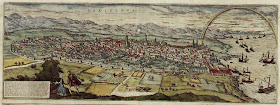 |
| A 19th century engraving of the Pont de Pierre. |
Throughout Bordeaux's long history there wasn't much need for a permanent river crossing. The city's development was confined to the left bank of the Garonne River where the deep water allowed large ships to dock. In contrast, the right bank remained largely agricultural -- planted with grape vines -- until the mid-19th century. For hundreds of years barges and rafts were the only means of transportation from one side to the other.
That was the situation when Napoleon arrived
at Bordeaux in 1807 on his way to war in Spain. Lack of a permanent structure meant that his 350,000 troops had to be
ferried across the Garonne. Now wait -- before you read any further just think about
that for a minute. A city of men, horses, tents, provisions, livestock, military supplies, and all of the artillery necessary for
waging a war, loaded onto wooden barges, carried across the turbulent Garonne, and unloaded on the opposite bank. This must
have been an enormous undertaking, and although I haven't found any description
of how it was accomplished, or how long it took, I'm willing to bet that the feisty
little Emperor wasn't too happy with the situation. It's not surprising that he
ordered the immediate construction of a permanent river crossing.







